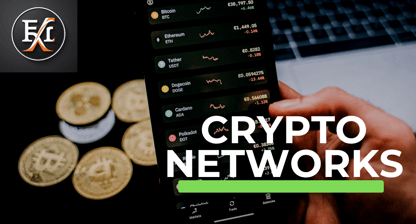Crypto Networks


Crypto Networks
A crypto network, also known as a blockchain network, is a decentralized digital infrastructure that enables the operation, maintenance, and validation of a cryptocurrency.
Here's an overview of some major cryptocurrency networks along with their key features:
1. Bitcoin (BTC)
Key Features:
First Cryptocurrency: Launched in 2009 by an anonymous entity known as Satoshi Nakamoto.
Decentralization: Operates without a central authority, using a peer-to-peer network.
Proof of Work (PoW): Uses a consensus mechanism requiring miners to solve complex mathematical problems to validate transactions.
Fixed Supply: Capped at 21 million bitcoins.
2. Ethereum (ETH)
Key Features:
Smart Contracts: Supports programmable contracts that execute when predefined conditions are met.
Decentralized Applications (DApps): Platform for building and running DApps without downtime or fraud.
Ethereum Virtual Machine (EVM): Allows developers to deploy decentralized applications.
Transition to Proof of Stake (PoS): Moving from PoW to PoS with Ethereum 2.0 for improved scalability and energy efficiency.
3. Binance Smart Chain (BSC)
Key Features:
High Performance: High throughput for fast transactions.
EVM Compatibility: Compatible with Ethereum tools and DApps.
Dual Chain Architecture: Allows users to build decentralized apps and digital assets on one blockchain and take advantage of the fast trading on the other.
4. Cardano (ADA)
Key Features:
Proof of Stake (PoS): Uses the Ouroboros PoS protocol to secure the network.
Scalability and Interoperability: Designed to handle large numbers of transactions and work across various blockchain systems.
Academic Approach: Built on peer-reviewed research and evidence-based methods.
5. Solana (SOL)
Key Features:
High Throughput: Capable of handling thousands of transactions per second.
Low Transaction Costs: Designed to keep fees low.
Proof of History (PoH): A unique consensus algorithm that improves efficiency and speed.
6. Polkadot (DOT)
Key Features:
Interoperability: Enables different blockchains to transfer messages and value in a trust-free fashion.
Scalability: Uses parachains to handle many transactions on multiple chains in parallel.
Upgradability: Can upgrade without hard forks.
7. Avalanche (AVAX)
Key Features:
High Performance: Quick transaction finality (less than 2 seconds).
Scalability: Capable of handling thousands of transactions per second.
Interoperability: Allows different blockchain networks to interact.
8. Tezos (XTZ)
Key Features:
Self-Amending Blockchain: Can upgrade itself without the need for hard forks.
Proof of Stake (PoS): Uses PoS to secure the network.
Formal Verification: Can mathematically verify smart contracts for correctness.
9. Cosmos (ATOM)
Key Features:
Interoperability: Uses the Inter-Blockchain Communication (IBC) protocol to enable communication between different blockchains.
Scalability: Can support many blockchains (zones) within its ecosystem.
Tendermint Core: Uses a Byzantine Fault Tolerant (BFT) consensus mechanism.
10. Tron (TRX)
Key Features:
High Throughput: Capable of handling a large number of transactions per second.
Decentralized Applications (DApps): Supports DApps and smart contracts.
Content Sharing: Focused on enabling decentralized content sharing and entertainment platforms.
11. Algorand (ALGO)
Key Features:
Pure Proof of Stake (PPoS): Ensures full decentralization and security.
Speed and Efficiency: Fast transactions and low fees.
Immediate Finality: Transactions are confirmed quickly and cannot be altered once added to the blockchain.
12. Ripple (XRP)
Key Features:
Real-Time Settlement: Facilitates real-time, cross-border payments.
Scalability: Can handle large transaction volumes.
Consensus Algorithm: Uses a unique consensus algorithm different from PoW and PoS.
13. Litecoin (LTC)
Key Features:
Faster Block Generation: Generates blocks four times faster than Bitcoin.
Scrypt Algorithm: Uses Scrypt for its proof of work, which is more memory-intensive.
Low Transaction Fees: Generally has lower transaction fees compared to Bitcoin.
14. Stellar (XLM)
Key Features:
Cross-Border Transactions: Designed to facilitate cross-border transactions between any currencies.
Consensus Protocol: Uses the Stellar Consensus Protocol (SCP) which aims for fast processing and low fees.
Decentralized Exchange: Built-in exchange for trading any type of asset.
15. Chainlink (LINK)
Key Features:
Decentralized Oracles: Connects smart contracts with real-world data, APIs, and traditional bank payments.
Interoperability: Can be used across various blockchain networks.
Secure and Reliable: Uses multiple oracles to ensure data accuracy.
These networks are among the most prominent in the crypto space, each with its unique features and advantages.
